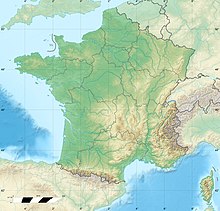Background
The region of Septimania was invaded by al-Samh ibn Malik al-Khawlani, wāli (governor-general) of al-Andalus, [4] in 719, and subsequently occupied by the Arab and Berber Muslim forces in 720. [1] [2] The region was renamed Arbūnah and turned into a military base for future operations by the Andalusian military commanders. [5]
By 721, al-Samh was reinforced and ready to lay siege to Toulouse, a possession that would open up the bordering region of Aquitaine to him on the same terms as Septimania. But his plans were thwarted in the disastrous battle of Toulouse in 721; the Aquitanian Christian army led by Odo the Great, Duke of Aquitaine defeated the Umayyad Muslim army and achieved a decisive and significant victory. [6] The surviving Umayyad forces drove away from Aquitaine with immense losses, in which al-Samh was so seriously wounded that he soon died at Narbonne. [6]
Arab and Berber Muslim forces, soundly based in Narbonne and easily resupplied by sea, struck in the 720s, conquering Carcassonne on the north-western fringes of Septimania (725) and penetrating eastwards as far as Autun (725). In 731, the Berber lord of the region of Cerdagne, Uthman ibn Naissa, called Munuza by the Franks, was an ally of the Duke of Aquitaine Odo the Great after he revolted against the Emirate of Córdoba, but the rebel lord was killed by the Arab Umayyad commander Abd al-Rahman ibn Abd Allah al-Ghafiqi. Following his success at the siege of Avignon in 737, Charles Martel besieged Narbonne [7] but his forces were unable to take the city, [8] after which the Frankish army marched on Nîmes, Agde, and Béziers. [7] [8]
Approaches
During the Early Middle Ages, an Andalusian garrison of Arab and Berber Muslim troops invaded the region of Septimania in 719 and deposed the local Visigothic Kingdom in 720. [1] [2] In 752, after the Carolingian king Pepin the Short obtained the Pope's recognition and the dignity of King of the Franks and deposing the last Merovingian king, Pepin felt free to focus all his might on subduing the Septimania and Provence. [1]
After capturing Bordeaux on the wake of Duke Hunald's detachment attempt, the Carolingian king Charles Martel directed his attention to Septimania and Provence. [7] While his reasons for leading a military expedition south remain unclear, it seems that he wanted to seal his newly secured grip on Burgundy, [7] now threatened by Umayyad occupation of several cities lying in the lower Rhône, or maybe it provided the excuse he needed to intervene in this territory ruled by Visigothic and Roman law, far off from the Frankish centre in the north of Gaul. In 737, the Frankish king went on to attack Narbonne, [7] [8] but the local nobility of Gothic and Gallo-Roman stock had concluded different military and political arrangements to oppose the expanding Frankish realm. [9] Charles Martel attempted to conquer the whole region of Septimania and besieged Narbonne in 737 [7] but his forces were unable to take the city. [8] However, when the Arabs sent reinforcements from Muslim-ruled Iberia, the Frankish Christian army intercepted them at the mouth of the River Berre (located in the present-day Département of Aude) and achieved a decisive and significant victory, [6] [7] after which the Frankish army marched on Nîmes. [7] [8]
While the Gothic magnates did not support the Franks formerly, things were changing this time: Nîmes, Agde, and Béziers were handed over to him by the Gothic count Ansemund. [10] Mauguio surrendered too. Count Miló was at the time ruling in Narbonne as a vassal of the Andalusians, but when Ansemund handed over several cities to Pepin, Miló did not join, probably deterred by the Arab-Berber Muslim garrison stationed in the city.

Year 714 (DCCXIV) was a common year starting on Monday of the Julian calendar. The denomination 714 for this year has been used since the early medieval period, when the Anno Domini calendar era became the prevalent method in Europe for naming years.
The 730s decade ran from January 1, 730, to December 31, 739.
The 720s decade ran from January 1, 720, to December 31, 729.
The 710s decade ran from January 1, 710, to December 31, 719.

Year 721 (DCCXXI) was a common year starting on Wednesday of the Julian calendar. The denomination 721 for this year has been used since the early medieval period, when the Anno Domini calendar era became the prevalent method in Europe for naming years.
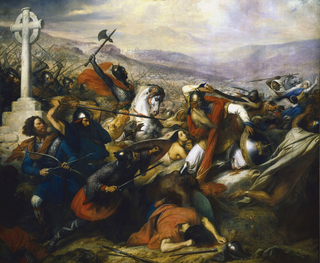
The Battle of Tours, also called the Battle of Poitiers and the Battle of the Highway of the Martyrs, was fought on 10 October 732, and was an important battle during the Umayyad invasion of Gaul. It resulted in the victory for the Frankish and Aquitanian forces, led by Charles Martel, over the invading Muslim forces of the Umayyad Caliphate, led by Abd al-Rahman al-Ghafiqi, governor of al-Andalus. Several historians, such as Edward Gibbon, have credited the Christian victory in the battle as an important factor in curtailing the Islamization of Western Europe.

Abd al-Rahman ibn Abd Allah Al-Ghafiqi, was an Arab Umayyad commander and governor who led Andalusian Muslim forces against the Franks. His invasion failed and was killed in action against the forces of Charles Martel in the Battle of Tours on October 10, 732 AD.

Septimania is a historical region in modern-day southern France. It referred to the western part of the Roman province of Gallia Narbonensis that passed to the control of the Visigoths in 462, when Septimania was ceded to their king, Theodoric II. During the Early Middle Ages, the region was variously known as Gallia Narbonensis, Gallia, or Narbonensis. The territory of Septimania roughly corresponds with the modern French former administrative region of Languedoc-Roussillon that merged into the new administrative region of Occitanie. In the Visigothic Kingdom, which became centred on Toledo by the end of the reign of Leovigild, Septimania was both an administrative province of the central royal government and an ecclesiastical province whose metropolitan was the Archbishop of Narbonne. Originally, the Goths may have maintained their hold on the Albigeois, but if so it was conquered by the time of Chilperic I. There is archaeological evidence that some enclaves of Visigothic population remained in Frankish Gaul, near the Septimanian border, after 507.
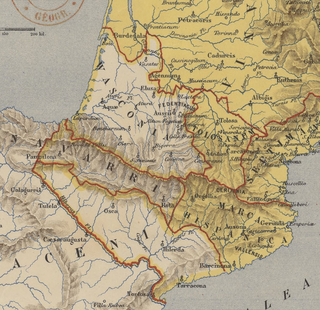
The Spanish March or Hispanic March was a military buffer zone beyond the former province of Carolingian Septimania established by Charlemagne in 795 as a defensive barrier between the Muslim-ruled Umayyad Caliphate] of al-Andalus and the Frankish Carolingian Empire.
Ansemund was the Gothic count of Nîmes, ruling from 752 until his death in 754.
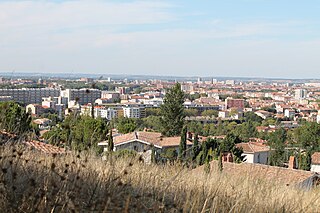
The Battle of Toulouse (721) was a victory of an Aquitanian Christian army led by Odo the Great, Duke of Aquitaine over an Umayyad Muslim army besieging the city of Toulouse, led by al-Samh ibn Malik al-Khawlani, the Umayyad wāli (governor-general) of al-Andalus. The decisive Aquitanian victory checked the spread of Umayyad control westward from Narbonne into Aquitaine.
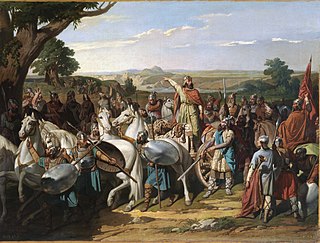
The Muslim conquest of Iberia was an invasion of the Iberian Peninsula by the Umayyad Caliphate that occurred from approximately 711 to the 720s. The conquest resulted in the defeat of the Visigothic Kingdom and the establishment of the Umayyad Wilayah of Al-Andalus.
Al-Samh ibn Malik al-Khawlani was the Arab governor general of Al-Andalus from between 719 and 721. In 720, under his governorate he minted the first purely Arab coins in Al-Andalus as part of his fiscal reforms.

The siege of Avignon was contested in 737. Frankish forces led by Charles Martel defeated the Umayyad garrison of Avignon and destroyed the stronghold.
The siege of Narbonne was fought in 737 between the Arab and Berber Muslim forces of Yusuf ibn Abd al-Rahman al-Fihri, Arab Umayyad Muslim governor of Septimania on behalf of al-Andalus, and the Frankish Christian army led by the Carolingian duke Charles Martel.
The Battle of the River Berre was fought in 737 between the Arab and Berber Muslim forces of Yusuf ibn Abd al-Rahman al-Fihri, Arab Umayyad Muslim governor of Septimania on behalf of al-Andalus, and the Frankish Christian army led by the Carolingian duke Charles Martel during the siege of Narbonne. The battle, which took place at the mouth of the River Berre, was a significant victory for Charles Martel in the military campaigns of 736–737. During this period, Martel effectively prevented greater Umayyad expansion beyond the Pyrénées.
Septimania was the western region of the Roman province of Gallia Narbonensis that passed under the control of the Visigoths in 462. It passed briefly to the Emirate of Córdoba in the eighth century before its reconquest by the Franks, who by the end of the ninth century termed it Gothia. This article presents a timeline of its history.
Al-Ḥurr ibn ʿAbd al-Raḥmān al-Thaqafi was an early Umayyad governor who ruled the Muslim province of Al-Andalus from between 716 and 718. He was the third successor to Musa bin Nusair, the North African governor who had directed the conquest of Visigothic Hispania several years earlier in 711. Al-Hurr was the first Muslim commander to cross the Pyrenees in 717, leading a small raiding party into Septimania. His incursions were largely unsuccessful, for which he was deposed in 718.

The Umayyad invasion of Gaul occurred in two phases in 719 and 732 AD. Although the Umayyads secured control of Septimania, their incursions beyond this into the Loire and Rhône valleys failed. By 759 Muslim forces had lost Septimania to the Christian Franks and retreated to Iberia.
The siege of Barcelona was a military operation by a Carolingian army with the aim of conquering the city of Barcelona, which had been under Muslim control for 80 years. The siege and conquest were part of the expansion of the Marca Hispanica and the constitution of the County of Barcelona by the Carolingians.

